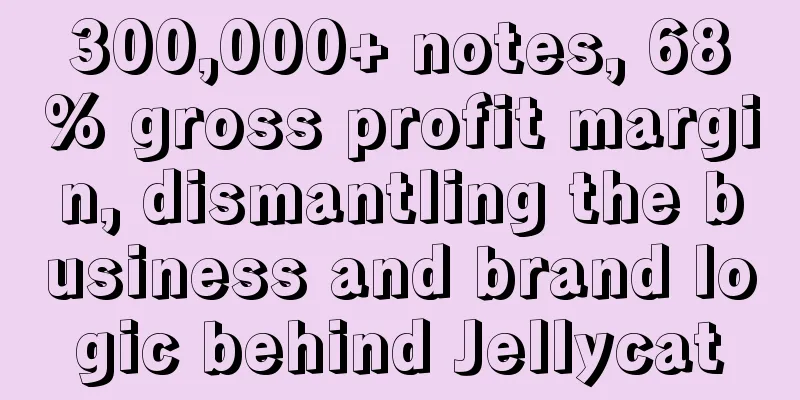From the cases of Luckin Coffee, Bawangchaji, and Lululemon, we can summarize 3 growth trends

The previous analysis focused on Luckin Coffee’s growth model, which also involved Starbucks, Bawang Chaji, and Lululemon. From these tens of thousands of words, I extracted three growth trends: 1. Efficiency vs. quality, an extremely polarized growth strategyThe development of human society and the business world has shown a clear polarization trend in many areas: either extreme efficiency or extreme quality. If we follow this rule of the game, Luckin Coffee will definitely choose efficiency as its first choice. Essentially, they are an Internet company and a big data company. The business model must be clearly understood before this can be accomplished. This is the foundation. Product quality, brand, and service are all centered around extreme efficiency. Don’t be fooled by Luckin’s talk about its coffee beans and the awards it has won, these are just promotional methods. If you are looking for quality and taste, their fully automatic coffee machines definitely can’t do it, this is the basic logic of making coffee; if you are looking for service experience and tone, they have almost no sense of independent space. What is a truly high-quality coffee brand? It can only be an independent boutique coffee shop, and it is absolutely impossible to open a large-scale store. Because: 1) The coffee making process is inherently slow, with many operating procedures. The differentiated taste can only be perceived in the coffee beans themselves, the depth of roasting, the temperature, the air pressure, etc., and it is more obvious for people who drink it frequently. 2) The mood of coffee lies in this complex and slow process, which gives people an immersive and healing feeling. But according to this model, the cafe cannot make money. There are few customers who have this demand, and most of them come on weekends and stay for half a day, resulting in low turnover. In addition, the location cannot be too remote otherwise there will be no living atmosphere, so the rent is high... These reasons will eventually lead to low profits, which is essentially because the money circulation efficiency is too low. Therefore, high-quality coffee shops or brands can also be considered a kind of positioning, but the characteristics of this category make it difficult to make money and it is impossible to grow big. Why are Starbucks' revenue and profits declining? The reason can be seen here. It has neither extreme efficiency nor good quality. It is in the middle ground and has nothing. A cup of coffee costs 30 yuan, but you can't really tell the difference between good and bad coffee. There are too many people in the coffee shop, the seats are uncomfortable, and the service is not good, which is incomparable to that of an independent coffee shop. Especially when compared with Luckin Coffee, this feeling of being neither good nor bad is even more obvious. This logic can be extended to other industries, such as Chinese fast food. Brands like Lao Xiang Ji play a role similar to canteens, which are convenient, hygienic, and inexpensive. This positioning requires that every link is fast, especially the food delivery. Therefore, there are pre-prepared dishes to ensure efficiency. With more pre-prepared dishes, I found that when giving good reviews to restaurants, people will say: It has the flavor of a wok. This is basically the opposite of pre-prepared food. Customers will definitely feel better when eating it, but the sacrifice is efficiency. Not only will customers have to wait longer, but the time and cost of making the food will also be longer, so it is only suitable for small non-chain restaurants. This is also a choice of efficiency and quality. Are there any brands or supplies that combine efficiency and quality? Yes, but it is very rare. And it will also sacrifice some other elements. The example is Sam's Club, which fully meets the goals that e-commerce has always pursued: more, faster, better, and cheaper. It offers large-packaged goods, better quality, more choices, and convenient shopping. From this perspective, it basically takes both efficiency and quality into account. This is already a very rare and high-quality case. For this business model to work, other factors must be sacrificed: 1) There is a membership fee, which is a threshold that blocks most people; 2) The location is remote and inconvenient, and it is even more inconvenient if you don’t have a car. 2. Professional vs. mass market: dividing the incremental marketThe group that conducts more specialized and in-depth research in a certain field must be a minority. This is the logic of probability. Each of us has a very general and superficial understanding of most of the areas we come into contact with, and even has many misconceptions. This is why science and the public are almost antonyms, why there is science popularization, and why once the media becomes popular, there will be a lot of pseudoscience. From the early public accounts to the current Douyin video accounts, they all reflect this law. In the case of Luckin Coffee, this is reflected in the choice of the user group and the insight into the needs of this group. Strictly speaking, coffee refers to those few classic types. The actual audience for these types of coffee in China is very small. Only a small elite group will pay for them. They can be considered more professional coffee lovers. Luckin Coffee cannot grow big by targeting this group of people, as the market is too small. Making coffee into a beverage means that it is no longer targeting professional coffee lovers, and the entire audience market is much larger. There are many such extended cases. For example, Arc'teryx vs Camel's jackets, the former has a very small target group. Although it has strong purchasing power, the ceiling is also there; the latter basically attracts the young masses. The professional and the general public here are relative. The professional here does not refer to superb specialized skills, but rather the specialization in needs or characteristics. To understand this, one must have a basic understanding of Chinese society. For example, the 100 million people who fly frequently are a professional group with higher incomes and are more business-oriented, so placing commercial advertisements at airports is particularly accurate. For another example, people who read books are more specialized, because from the perspective of China, the number of people who can seriously read a few books a year is definitely a minority, so tools for listening to books can reach the mass market. 3. MVP first, the only way to scientific growthWhen most people were paying attention to Luckin Coffee, it already had at least several thousand stores and had begun to take shape, and its dual flywheel model was also easy to understand. But looking back at their growth process, we found that the MVP they made in the early days was truly valuable and inspiring to us. This is the starting point of the flywheel, the cold start method. 1) Being close to the water, they first sold coffee in the lobby of the Shenzhou headquarters and ran the operation process and data model. This is also the reason why Luckin Coffee started with white-collar workers. On the one hand, they were familiar with it, and on the other hand, the first wave of MVP users were white-collar workers. 2) When promoting the business later, we mainly opened takeaway stores in different regions. This had low costs, but it was also possible to verify the single-store model and accumulate user data and site selection effects. This MVP verification method is the best way to achieve growth scientifically. Otherwise, how can a team of executives from the car rental business create a coffee brand? It is useless to recruit people with successful experience, because what they want to do is to innovate models, and what they want to address are relatively blank markets and population needs, and they have to do it to the extreme, so MVP is the best way to help the founding team find the feeling. I also thought of a fun MVP that is rough and useful. When Mengniu’s founder Niu Gensheng founded the ice cream brand Aice, he used Mengniu’s previous recipe, but he was not sure whether Southeast Asian users would like it, so he wanted to make an MVP. If we follow the normal thinking, this MVP is small-scale production + small-scale deployment. But his method is to directly airfreight from China and sell it locally, which saves the production process and time, and is a flexible and useful MVP implementation plan. |
<<: Brand Marketing Strategy in “It” Economy
>>: Taotian Jingdong: One dilemma, two solutions
Recommend
Are there any sea freight costs? What are the costs of sea freight?
Nowadays, cross-border e-commerce platforms have r...
Can Shopee coupons be used in combination? How to set it up?
Coupons have always been one of the marketing meth...
Internet celebrity Quan Xing was blocked, these 7 types of IPs are very dangerous!
This article tells the reasons why various interne...
Another 618, no winners
Why is there no winner in this year's 618? Thi...
Middle-aged Alibaba, the value lies in hard work
This article mainly analyzes Alibaba's first q...
How is the creative profit-sharing plan divided?
Recently, the "creative profit sharing plan&q...
eBay UK will restore final value fees for electronics and home gardening categories
eBay announced that the fixed portion of the trans...
Tea sellers are frantically diverting traffic to private domains
As the Spring Festival approaches, the amount of a...
The "solution" you choose determines how expensive your product can be sold!
This article raises a question: There are countles...
How do I set a password for an Amazon prepaid return label? How do I fill in the return settings?
As one of the world's largest e-commerce platf...
In the fur live broadcast room, we can see the confidence of women's clothing e-commerce
Explore the new realm of women's clothing e-co...
Is Wish's no-source model a scam? Is it reliable?
Now many friends want to open a store. Compared wi...
Mixue Ice City, disrupting music festival marketing again
Mixue Ice City announced that it would launch an &...
Can I still ship if the Amazon IPI is less than 500? How to improve Amazon IPI?
Amazon ipi is very important data. Merchants need ...
Meituan Instant Retail Conference revealed several key data sets
This article will give you an in-depth understandi...

![Damn! I'm surrounded by the wool party [Part 2]](/upload/images/67e74c20c5c60.webp)







